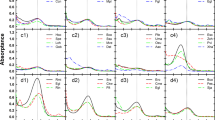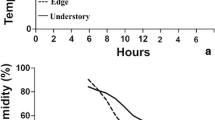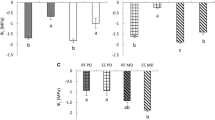Abstract
Several deciduous woody plant species produce anthocyanins during leaf development in spring and again during leaf senescence in autumn. The leaves of Betula pendula Roth (silver birch) commonly exhibit transient reddening in juvenile leaves under northern growing conditions, with the intensity of the red colour varying among individual trees. The objective of our study was to test the hypothesis that the accumulation of foliar anthocyanins during spring in leaves of B. pendula is an ecotypic response. Chlorophyll fluorescence ratio (Fv/Fm), leaf reflectance and anthocyanin concentrations were measured, in relation to phenology in spring, summer and autumn from birches used for landscaping with either red or green-emergent leaves. The results suggest that (1) the trees with green- or red-emergent juvenile leaves represent different populations, and (2) that the red-emergent leaves senesced earlier, indicating that (3) trees with red-emerging leaves belong to a more northern ecotype than the trees with green-emerging leaves. The role of anthocyanin synthesis in a northern radiation environment is discussed.




Similar content being viewed by others
References
Archetti M (2009) Classification of hypotheses on the evolution of autumn colours. Oikos 118:328–333
Björkman O, Demmig B (1987) Photon yield of O2 evolution and chlorophyll fluorescence characteristics at 77 K among vascular plants of diverse origins. Planta 170:489–504
Chalker-Scott L (1999) Environmental significance of anthocyanins in plant stress responses. Photochem Photobiol 70:1–9
Close D, Beadle C (2003) The ecophysiology of foliar anthocyanins. Bot Rev 69:149–161
Coley PD, Barone JA (1996) Herbivory and pant defences in tropical forests. Annu Rev Ecol Syst 27:305–335
Dhindsa RS, Plumb-Dhindsa P, Thorpe TA (1981) Leaf senescence: correlated with increased levels of membrane permeability and lipid peroxidation, and decreased levels of superoxide dismutase and catalase. J Exp Bot 32:93–101
Fracheboud Y, Luquez V, Björken L, Sjödin A, Tuominen H, Jansson S (2009) The control of autumn senescence in European Aspen1[W][OA]. Plant Physiol 149:1982–1991
Gausman HW (1974) Leaf reflectance of near infrared, photogrammed engineering, 1974 convention in St. Louis, 10–15 Mar 1974, pp 183–191
Gould K, Markham K, Smith R, Goris J (2000) Functional role of anthocyanins in the leaves of Quintinia serrata A. Cunn. J Exp Bot 51:1107–1115
Heide O (1974) Growth and dormancy in Norway spruce ecotypes (Picea abies). Interaction of photoperiod and temperature. Physiol Plant 30:1–12
Hoch W, Zeldin E, McCown B (2001) Physiological significance of anthocyanins during autumnal leaf senescence. Tree Physiol 21:1–8
Hughes N, Morley C, Smith W (2007) Coordination of anthocyanin decline and photosynthetic maturation in juvenile leaves of three deciduous tree species. New Phytol 175:675–685
Junttila O (1980) Effect of photoperiod and temperature on apical growth cessation in two ecotypes of Salix and Betula. Physiol Plant 48:347–352
Junttila O (2007) Regulation of annual shoot growth cycle in northern tree species. In: Taulavuori E, Taulavuori K (eds) Physiology of northern plants under changing environment. Research Signpost, Kerala, India, pp 177–210
Kauppi A, Ulvinen T (1989) Two new forms of Betula pubescens from Finland. Memo Soc Fauna Flora Fenn 65:133–136
Knipling E (1970) Physical and physiological basis for the reflectance of visible and near-infrared radiation from vegetation. Remote Sens Environ 1:155–159
Kramer PJ, Kozlowski TT (1979) Physiology of woody plants. Academic Press, London
Lee D, O’Keefe J, Holbrook NM, Field TS (2003) Pigment dynamics and autumn leaf senescence in a New England deciduous forest, eastern USA. Ecol Res 18:677–694
Leyva A, Jarillo J, Salinas J, Martinez-Zapater J (1995) Low temperature induces the accumulation of phenylalanine ammonia-lyase and chalcone synthase mRNAs of Arabidopsis thaliana in a light-dependent manner. Plant Physiol 108:39–46
Mancinelli A, Hoff A, Cottrell M (1988) Anthocyanin production in Chl-rich and Chl-poor seedlings. Plant Physiol 86:652–654
Maxwell K, Johnson G (2000) Chlorophyll fluorescence—a practical guide. J Exp Bot 51:659–668
Ottander C, Öquist G (1991) Recovery of photosynthesis in winter-stressed Scots pine. Plant Cell Environ 14:345–349
Ottander C, Campbell D, Öquist G (1995) Seasonal changes in photosystem II organisation and pigment composition in Pinus sylvestris. Planta 197:176–183
Steyn W, Wand S, Holcroft D, Jacobs G (2002) Anthocyanins in vegetative tissues: a proposed unified function in photoprotection. New Phytol 155:349–361
Stone C, Chisholm L, Coops N (2001) Spectral reflectance characteristics of eucalypt foliage damaged by insects. Aust J Bot 49:669–687
Tahkokorpi M, Taulavuori K, Laine K, Taulavuori E (2007) After-effects of drought-related winter stress in previous and current year stems of Vaccinium myrtillus L. Environ Exp Bot 61:85–93
Taulavuori K (2005) A simple method to visualize the mechanism why Alnus glutinosa remains green during autumn colouration of Sorbus aucuparia. Trees 20:23–28
Taulavuori K, Taulavuori E, Laine K, Sarjala T, Savonen E-M, Pietiläinen P, Lähdesmäki P, Laine K (2000) J Plant Physiol 157:227–229
Taulavuori E, Tahkokorpi M, Taulavuori K, Laine K (2004) Anthocyanins and glutathione S-transferase activities in response to low temperature and frost hardening in Vaccinium myrtillus (L.). J Plant Physiol 161:903–911
Taulavuori K, Sarala M, Taulavuori E (2010) Growth responses of trees to arctic light environment. Prog Bot 71:157–168
Viherä-Aarnio A, Häkkinen R, Junttila O (2006) Critical night length for bud set and its variation in two photoperiodic ecotypes of Betula pendula. Tree Physiol 26:1013–1018
Acknowledgments
Support for this study was provided by the Botanical Gardens University of Oulu and the Thule Institute of the University of Oulu. Mr. Niilo Rankka from the University of Oulu, Biology Department is acknowledged for skilful technical assistance. Mr. Aaron Berghdal is thanked for the language editing, and Mrs Sally Ulich for proofreading. We also thank an anonymous referee for valuable comments.
Author information
Authors and Affiliations
Corresponding author
Additional information
Communicated by O. Junttila.
Rights and permissions
About this article
Cite this article
Taulavuori, K., Pihlajaniemi, H., Huttunen, S. et al. Reddish spring colouring of deciduous leaves: a sign of ecotype?. Trees 25, 231–236 (2011). https://doi.org/10.1007/s00468-010-0500-3
Received:
Revised:
Accepted:
Published:
Issue Date:
DOI: https://doi.org/10.1007/s00468-010-0500-3




